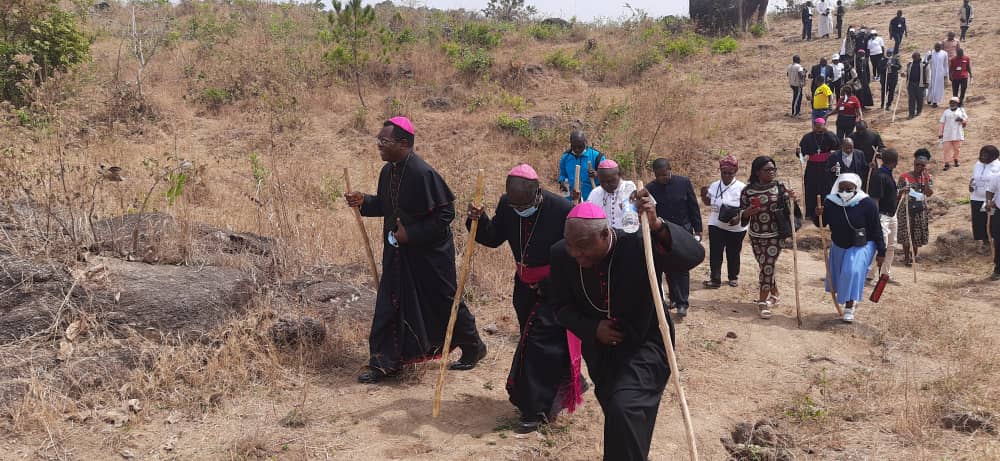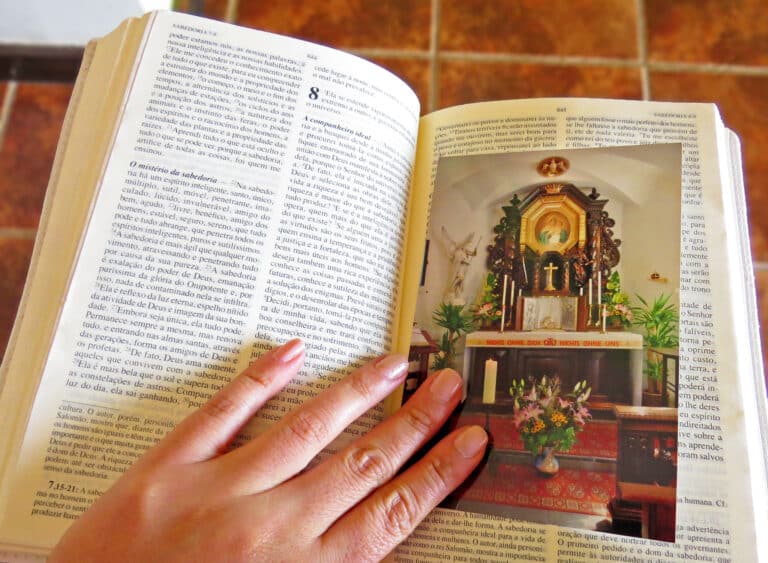Father Alois Baumberger, a Swiss missionary who belongs to the Schoenstatt Federation of Priests, has lived and worked in Africa for more than 40 years. Ten years ago, the Cameroonian bishops entrusted him with the construction of a place of pilgrimage in Marza, a project that had already been given in 1949 to the saintly Bishop Yves Plumey, who initiated it. He was later assassinated and the project was forgotten. In the last ten years, Father Alois has built this diocesan pilgrimage center in Marza, which not only means building a large pilgrimage church and creating facilities for pilgrims and for conferences, but also tending to the people in their many needs and being there for their questions and problems.
Pilgrims contribute by cleaning, weeding, helping in construction work, cooking, etc.
Schoenstatt spirituality integrated into the Cameroon pilgrimage site
Father Alois has made great contributions using Schoenstatt spirituality. The pilgrims are fascinated by this pilgrimage place, which was not built because of a Marian apparition, but because here people found inner healing, liberation from corruption, inner peace, a job, a pregnancy, etc. Mary, Our Lady of the Apostles – She is venerated in Marza under this title- attracts people of all colors and religious affiliations and provides them with a home, security, docility, and creative energy.
The 45th Bishops’ Conference of Cameroon visits the Marza shrine

In the last few days, the 45th Episcopal Conference of Cameroon visited the shrine and wanted Father Alois to give them spiritual and historical information about the place. Father Alois writes: “We gave them a pilgrim’s cane, a packet of artemisia – natural medicinal tea – with the picture and the name of their respective dioceses printed on it, and a copy of the meditations of our Stations of the Cross and Easter, small tokens that they deeply appreciated. They were all very impressed by the house of the founding Bishop Yves Plumey, where he died thirty years ago”.
Alois’ words of welcome to the bishops of the 45th Episcopal Conference
It is thanks to the City Administration, which has courageously taken up the hoe and the machete to pave the way for people to come here to Mary, Our Lady of the Apostles, that this meeting is possible today.
Mary is often depicted with a hoe in her hand. In Africa, the hoe was not only used for weeding, but also for kneading mud and building new things.
Just like here in Marza, where a center for meeting, formation and pilgrimage is being built on this holy mountain that presents itself with its social, charitable, and cultural facilities as a place for lay apostolate. It is the site for the national shrine.
Father Alois told the bishops, “You and many others are rooted in the history of evangelization and know that there are churches and shrines – as well as temples, mosques and pagodas – that have been teaching centers where the wisdom of your religion has been spread throughout history. They are not buildings that carry the message, but rather firmly established places from which it is transmitted to all generations, from generation to generation.”
Father Alois commented that the previous bishop of this diocese had said about this shrine, “This is not a place of pilgrimage, it is Paradise’s wayside shrine!”
The beauty of the place lifts the soul towards God.

What is impressive in Marza, according to Father Alois Baumberger, is that visitors or pilgrims often felt very comfortable in particular places in this center. They felt the aroma of a sacred place. They felt drawn to them and had the desire to stay in these places to feel revived, they had discovered a place that enriched their soul. “Man is a multidimensional being and is enveloped in a biodynamic sphere that makes him sensitive to the discovery of places with which he feels connected or in communion,” said the priest.
In this National Shrine, he said, a special energy is felt around the spring that feeds the well, but there are also the “guardians of the place“. They are rock formations that have the outline of a human face with eyes, ears, and mouth. Pilgrims say that when you approach them, they see you, listen to you and ask you questions such as: What is the purpose of your presence?
Other places of grace are Mary’s Grotto, the large cross, Mary’s Path and, above all, the set of peaks and caves behind the wayside shrine, where one can very well find peace and inner serenity.
The large and small pilgrimage sites of our land, with their sources of energy, of graces, are like storehouses or batteries with great power, which are recharged over and over with the pilgrims’ visits and their celebrations.
Nothing without you, nothing without us

A place where beauty, silence and inner peace are celebrated
The Shrine of Our Lady of the Apostles is a place where beauty, silence and inner peace are celebrated. Those who come to the Marian Shrine of Marza seek to get away from the monotony of everyday life, from routine and painful events, they seek to return to fundamental values. The pilgrim seeks guidance, asks for intercession for a project close to his heart, wants to be healed from inner torments or supported in a difficult moment. Pilgrims come for themselves, for the intentions of loved ones or for world peace. The Marza Shrine wants to be a stepping-stone in life, a turning point on the path of those seeking to make sense of it all and seeking God, a story of love between God and mankind.



